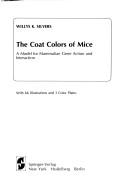| Listing 1 - 4 of 4 |
Sort by
|
Book
ISBN: 0520023471 9780520023475 Year: 1976
Abstract | Keywords | Export | Availability | Bookmark
 Loading...
Loading...Choose an application
- Reference Manager
- EndNote
- RefWorks (Direct export to RefWorks)
Animal pigments --- Animals --- Structural colors --- Color --- Schemochromes --- Colors --- Animal coloration --- Coat color of animals --- Color of animals --- Coloration in animals --- Color in nature --- Zoochromes --- Pigments (Biology) --- Chromatophores --- Animals - Color
Book
ISBN: 9812709754 9789812709752 9812707832 9789812707833 Year: 2008 Publisher: Singapore Hackensack, N.J. World Scientific Pub. Co.
Abstract | Keywords | Export | Availability | Bookmark
 Loading...
Loading...Choose an application
- Reference Manager
- EndNote
- RefWorks (Direct export to RefWorks)
Structural colorations originate from self-organized microstructures, which interact with light in a complex way to produce brilliant colors seen everywhere in nature. Research in this field is extremely new and has been rapidly growing in the last 10 years, because the elaborate structures created in nature can now be fabricated through various types of nanotechnologies. Indeed, a fundamental book covering this field from biological, physical, and engineering viewpoints has long been expected.Coloring in nature comes mostly from inherent colors of materials, though it sometimes has a purely p
Animals --- Structural colors. --- Animal pigments. --- Plants --- Color of plants --- Color in nature --- Plant pigments --- Zoochromes --- Pigments (Biology) --- Chromatophores --- Schemochromes --- Colors --- Animal coloration --- Coat color of animals --- Color of animals --- Coloration in animals --- Animal pigments --- Color. --- Color

ISBN: 0387903674 Year: 1979 Publisher: New York (N.Y.): Springer
Abstract | Keywords | Export | Availability | Bookmark
 Loading...
Loading...Choose an application
- Reference Manager
- EndNote
- RefWorks (Direct export to RefWorks)
Animals --- Mammals --- Mice --- Hair Color --- Color, Hair --- Colors, Hair --- Hair Colors --- House mice --- House mouse --- Mouse --- Mus musculus --- Rodents --- Animal coloration --- Coat color of animals --- Color of animals --- Coloration in animals --- Color in nature --- Animal pigments --- Color --- Genetics --- genetics --- Animal genetics. Animal evolution
Book
ISBN: 0253050731 Year: 1977 Publisher: Indiana University Press
Abstract | Keywords | Export | Availability | Bookmark
 Loading...
Loading...Choose an application
- Reference Manager
- EndNote
- RefWorks (Direct export to RefWorks)
Why do visual signals have the characteristics that they do? Why do animals (including man) gesture, posture, and move in communicative fashions? Why are animals colored and patterned in particular ways? Optical Signals is the first attempt to answer these and related questions. After presenting a synthetic framework of social communication, ethology, mathematical information theory, and semiotics, Hailman explains the relevant background: considerations of the physics of light that carry information from sender to receiver, and properties that limit the receiver's ability to get and send information encoded in light. Next Hailman puts together data from different disciplines in order to discover the "design characteristics" of optical signals. The major part of the book concerns these design characteristics and factors that influence them: behavioral patterns and coloration that look like visual signals but are not, principles of visual deception, and the way in which the physical and biological environment structures the characteristics of signals. Lastly, the book considers how the message being transmitted influences the design of the signal itself.
Tiere. --- Optisches Signal. --- Kommunikation. --- Animals --- Animal communication. --- Animaux --- Communication animale. --- Color. --- Couleur. --- Animal biocommunication --- Animal language --- Biocommunication, Animal --- Language learning by animals --- Animal behavior --- Animal coloration --- Coat color of animals --- Color of animals --- Coloration in animals --- Color in nature --- Animal pigments --- Literary theory
| Listing 1 - 4 of 4 |
Sort by
|

 Search
Search Feedback
Feedback About UniCat
About UniCat  Help
Help News
News